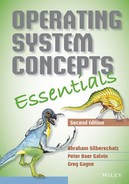Contents
1.2 Computer-System Organization
1.3 Computer-System Architecture
1.4 Operating-System Structure
1.5 Operating-System Operations
1.12 Open-Source Operating Systems
Chapter 2 Operating-System Structures
2.2 User and Operating-System Interface
2.6 Operating-System Design and Implementation
2.7 Operating-System Structure
2.8 Operating-System Debugging
2.9 Operating-System Generation
3.4 Interprocess Communication
3.6 Communication in Client–Server Systems
Chapter 5 Process Synchronization
5.2 The Critical-Section Problem
5.7 Classic Problems of Synchronization
6.5 Multiple-Processor Scheduling
7.3 Contiguous Memory Allocation
7.6 Structure of the Page Table
7.7 Example: Intel 32 and 64-bit Architectures
8.10 Operating-System Examples
Chapter 9 Mass-Storage Structure
9.1 Overview of Mass-Storage Structure
9.8 Stable-Storage Implementation
Chapter 10 File-System Interface
10.3 Directory and Disk Structure
Chapter 11 File-System Implementation
11.2 File-System Implementation
11.6 Efficiency and Performance
11.9 Example: The WAFL File System
12.3 Application I/O Interface
12.5 Transforming I/O Requests to Hardware Operations
PART FIVE ![]() PROTECTION AND SECURITY
PROTECTION AND SECURITY
13.5 Implementation of the Access Matrix
13.7 Revocation of Access Rights
13.9 Language-Based Protection
14.3 System and Network Threats
14.4 Cryptography as a Security Tool
14.6 Implementing Security Defenses
14.7 Firewalling to Protect Systems and Networks
14.8 Computer-Security Classifications
